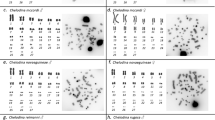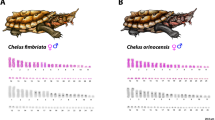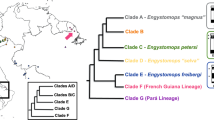Abstract
BOVEY1 reported that two male specimens of the common shrew (Sorex araneus L.), from Switzerland, had a sex-chromosome trivalent at first metaphase of meiosis. He did not examine female chromosomes, so was unable to determine whether the sex-chromosome mechanism was XY1Y2 : XX (the female having one sex-chromosome less than the male) or X1X2Y : X1X1X2X2 (the female having one sex-chromosome more than the male). Study of four male and two female shrews collected in Britain confirms the presence of a sex-chromosome trivalent in the male and shows that the female has but two sex-chromosomes (X X).
This is a preview of subscription content, access via your institution
Access options
Subscribe to this journal
Receive 51 print issues and online access
$199.00 per year
only $3.90 per issue
Buy this article
- Purchase on Springer Link
- Instant access to full article PDF
Prices may be subject to local taxes which are calculated during checkout
Similar content being viewed by others
References
Bovey, R., Rev. suisse Zool., 56, 371 (1949).
Sharman, G. B., and Barber, H. N., Heredity, 6, 345 (1952).
Matthey, R., Arch. Jul. Klaus-Stift., 27, 163 (1952).
Wahrman, J., and Zahavi, A., Nature, 175, 600 (1955).
White, M. J. D., “Animal Cytology and Evolution”, 2nd edit., 316 (Camb. Univ. Press, 1954).
White, M. J. D., Evolution, 5, 376 (1951).
Author information
Authors and Affiliations
Rights and permissions
About this article
Cite this article
SHARMAN, G. Chromosomes of the Common Shrew. Nature 177, 941–942 (1956). https://doi.org/10.1038/177941a0
Issue Date:
DOI: https://doi.org/10.1038/177941a0
This article is cited by
-
Chromosomal rearrangements and gene flow over time in an inter-specific hybrid zone of the Sorex araneus group
Heredity (2009)
-
A mosaic XY1Y2/XY1Y2Y2 common shrewSorex araneus
Acta Theriologica (2006)
-
Chromosome localization of microsatellite markers in the shrews of the Sorex araneus group
Chromosome Research (2006)
-
A taxonomical re-evaluation of the Valais chromosome race of the common shrewSorex araneus (Insectivora: Soricidae)
Acta Theriologica (2002)
-
NewSorex araneus karyotypes from Germany and the postglacial recolonization of central Europe
Acta Theriologica (2002)
Comments
By submitting a comment you agree to abide by our Terms and Community Guidelines. If you find something abusive or that does not comply with our terms or guidelines please flag it as inappropriate.



